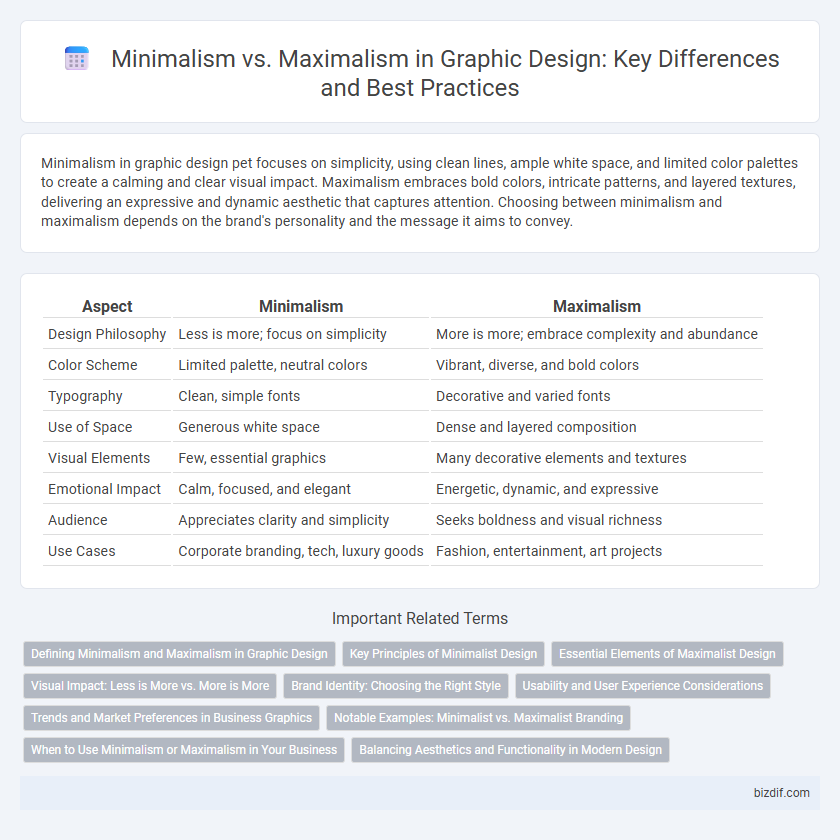Minimalism in graphic design pet focuses on simplicity, using clean lines, ample white space, and limited color palettes to create a calming and clear visual impact. Maximalism embraces bold colors, intricate patterns, and layered textures, delivering an expressive and dynamic aesthetic that captures attention. Choosing between minimalism and maximalism depends on the brand's personality and the message it aims to convey.
Table of Comparison
| Aspect | Minimalism | Maximalism |
|---|---|---|
| Design Philosophy | Less is more; focus on simplicity | More is more; embrace complexity and abundance |
| Color Scheme | Limited palette, neutral colors | Vibrant, diverse, and bold colors |
| Typography | Clean, simple fonts | Decorative and varied fonts |
| Use of Space | Generous white space | Dense and layered composition |
| Visual Elements | Few, essential graphics | Many decorative elements and textures |
| Emotional Impact | Calm, focused, and elegant | Energetic, dynamic, and expressive |
| Audience | Appreciates clarity and simplicity | Seeks boldness and visual richness |
| Use Cases | Corporate branding, tech, luxury goods | Fashion, entertainment, art projects |
Defining Minimalism and Maximalism in Graphic Design
Minimalism in graphic design emphasizes simplicity, using limited colors, clean lines, and ample white space to create a focused, uncluttered visual experience. Maximalism contrasts by embracing bold colors, intricate patterns, and layered elements that produce a rich, dynamic composition filled with details. Both styles define their approach through the intentional balance of visual elements, either by stripping down to essentials or by celebrating complexity and abundance.
Key Principles of Minimalist Design
Minimalist design emphasizes simplicity, clarity, and functionality by using limited color palettes, ample white space, and essential elements only. It prioritizes clean lines, geometric shapes, and balanced composition to create a visually pleasing and easily navigable layout. The key principles include reducing visual noise, focusing on content hierarchy, and ensuring every design choice serves a purpose.
Essential Elements of Maximalist Design
Maximalist design emphasizes bold patterns, vibrant colors, and a rich layering of textures to create visually dynamic compositions. Key essential elements include abundant detailing, diverse typography, and eclectic imagery that convey complexity and personality. This approach contrasts minimalist simplicity by embracing excess and ornamental richness to evoke emotional intensity and depth.
Visual Impact: Less is More vs. More is More
Minimalism in graphic design emphasizes simplicity through clean lines, ample white space, and limited color palettes to create a strong visual impact by guiding the viewer's focus to essential elements. Maximalism employs vibrant colors, intricate patterns, and layered textures, generating dynamic and attention-grabbing compositions that evoke complexity and abundance. Both approaches harness contrast and balance but differ fundamentally in how they engage and influence the viewer's perception of space and detail.
Brand Identity: Choosing the Right Style
Minimalism in brand identity emphasizes clean lines, limited color palettes, and simplicity to convey clarity and sophistication, often appealing to modern, upscale audiences. Maximalism embraces bold patterns, vibrant colors, and intricate details, creating a dynamic and memorable brand presence that captures attention and expresses creativity. Selecting between minimalism and maximalism depends on the target market, brand values, and desired emotional impact to ensure effective communication and recognition.
Usability and User Experience Considerations
Minimalism in graphic design enhances usability by reducing visual clutter, making interfaces intuitive and easy to navigate, which improves overall user experience. Maximalism offers rich visual storytelling through vibrant colors and intricate details but can overwhelm users if not balanced, potentially hindering usability. Designers must evaluate the target audience and context to choose the appropriate approach, ensuring aesthetic appeal aligns with functional clarity and user engagement.
Trends and Market Preferences in Business Graphics
Minimalism in graphic design emphasizes clean lines, ample white space, and restrained color palettes, aligning with current market preferences for clarity and brand recognition in business graphics. Maximalism, characterized by bold colors, intricate patterns, and layered elements, appeals to niche markets seeking to convey vibrancy and complexity, particularly in creative industries and advertising campaigns. Trends indicate a dominance of minimalistic designs in corporate branding due to their versatility and ease of adaptation across digital and print media.
Notable Examples: Minimalist vs. Maximalist Branding
Notable examples of minimalist branding include Apple and Muji, where clean lines, ample white space, and simple typography emphasize clarity and functionality. In contrast, maximalist branding like Gucci and Absolut Vodka features bold colors, intricate patterns, and eclectic visuals to create a rich and dynamic consumer experience. These approaches highlight how minimalist branding prioritizes simplicity and elegance, while maximalist branding embraces complexity and exuberance in graphic design.
When to Use Minimalism or Maximalism in Your Business
Minimalism suits businesses aiming for clarity and simplicity, enhancing user experience through clean layouts and limited color palettes, ideal for luxury brands and tech startups. Maximalism works well for brands seeking bold expression and emotional impact, using vibrant colors, intricate patterns, and eclectic typography to attract creative industries and fashion labels. Choosing between minimalism and maximalism depends on the target audience, brand identity, and the desired emotional response from customers.
Balancing Aesthetics and Functionality in Modern Design
Minimalism emphasizes clean lines, ample white space, and essential elements to create user-friendly interfaces that enhance functionality and reduce cognitive load. Maximalism embraces bold colors, intricate patterns, and layered textures, aiming to evoke emotional responses while maintaining usability through strategic hierarchy and clear navigation. Effective modern design balances these approaches by integrating minimalist clarity with maximalist creativity, ensuring both aesthetic appeal and seamless user experience.
Minimalism vs Maximalism Infographic

 bizdif.com
bizdif.com